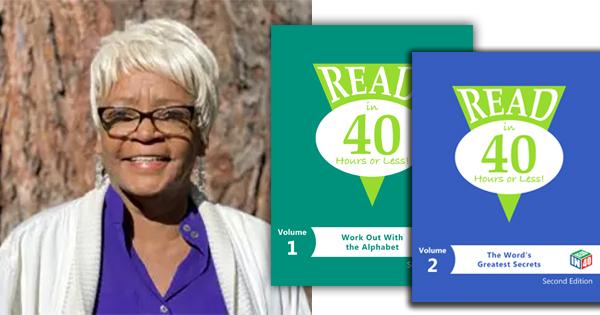Black Educator of 50 Years Says Her Workbook Series Can Help Every Child in America to Learn How to Read
“Over 85% of Black children attending our nation’s public schools don’t know how to read,” according to Berkeley, California teacher Rosa Higgs. But she insists that she has the best solution. She is the first Black woman to create a Phonics program that works. Her Phonics workbook series called Read in 40 is especially designed to help Black students learn to read at-or-above grade level.
Rosa has over fifty years of experience as an educator, with twenty of those years applied to Special Education. She has taught hundreds of struggling students to read throughout her teaching career. Rosa Higgs has long identified that teaching Phonics is the method that has consistently worked, even when teaching children with dyslexia. Phonics is the time-tested and scientifically proven method of decoding words the way students had done in the 1960s when students in California led the nation in aptitude and performance.
As a third-generation native of Berkley, California, with fifty-plus years of experience, Rosa Higgs was teaching before “the reading wars” began. As an educator, Rosa Higgs remembers how the shift to the Whole Language policy started, the nuances of change, and why the policy shifts occurred to the detriment of our nation’s school children. She had seen first-hand how political interference and policy changes impacted her students. Rosa recalls, “In the 1960s, nearly all students in California were proficient in Reading. California students had the highest test scores in the country. Black, white, and Spanish-speaking students received Phonics instruction, and all learned how to read well. The rest of the country modeled the state of California’s curriculum.”
She continues, “Black children were taught Phonics in segregated schools and were reading well. Before the integration of our nation’s public schools, teachers in segregated schools taught black kids how to read, and we taught them using Phonics. Everyone learned Phonics in the state of California until the schools were integrated. Every student also had the option to learn a musical instrument until Ronald Reagan became governor. That’s when things went down. Republicans changed the curriculum, pushing the Whole Language Method, exclusively.”
The Whole Language approach stresses reading together and using pictures, syntax, and context to guess the meaning of words instead of learning how to decode words and sentences in the language the child already knows.
“The Whole Language approach doesn’t teach how to decode words a child has never seen or heard before. Black students became confused. California was number one in the whole nation every year. Republicans soon mandated that all textbook approvals had to come through the state of Florida, and that destroyed our statistics. The whole country copied California’s curriculum for K-12 teaching, until the problem became widespread. Today we are number 48.”
“No Child Left Behind was signed into Law by George W. Bush in 2001 to hold schools accountable for student performance and fine schools that failed to show improvement. Schools in Black neighborhoods are already under-resourced and cash-strapped. This caused the problem to spin out of control.”
Rosa, one of several activists instrumental in our nation’s move to recognize Earth Day, has since dedicated herself to advocating for the state of California to abandon its Whole Language policy and return to the proven system of Phonics-based instruction. “Black teachers had to advocate to get Phonics back into our schools.”
Over twenty years ago, she took her commitment further and developed the Read in 40 workbook series, a Phonics-based program that helps quickly teach struggling students how to read. This four-volume Phonics program actually teaches struggling students in less than 40 hours of direct instruction by decoding words. In her 50 years of hands-on instruction, Rosa Higgs discovered 7 Magnificent Rules of Phonics. These are the seven fundamental skills that all readers must-have, a system by design that distinguishes READ IN 40 from every other Phonics program on the market. “Phonics is not for Pre-K to 3rd grade alone. It’s for all people who want to learn to read well and learn quickly,” says Rosa Higgs.
“Everyone that I teach learns to read above grade level in forty hours or less, and that is why I chose the name,” says Rosa. “While other programs take over a year with moderate results, Read in 40 takes half a semester for a student’s reading aptitude to advance two or more levels. Direct instruction is also necessary for everybody, not only lower elementary school kids.”
Thanks to Read in 40, more students all across the country are learning how to read well and Read in 40 has gained support from school boards, Howard University Department of Education Professor James Jackson, the Berkeley NAACP, and everyday teachers and principals.
The Alpha Phi Alpha, Fraternity Inc., a national and international fraternal organization of educated Black men, members Elihu Harris, former Oakland, CA Mayor and Donald White, awarded a grant to Rosa Higgs and READ IN 40 to continue grassroots efforts to promote literacy in the Black community and disenfranchised communities all across America. “Regardless of age or cognitive handicaps, all people need Phonics to learn to read well,” says grantor, Donald White of Alpha Phi Alpha, Fraternity, Inc.
Throughout the pandemic, Rosa volunteered to teach students how to read at the Berkeley NAACP offices. Higgs became the chapter’s number-one volunteer, teaching students how to read. “Ms. Higgs was the only volunteer educator who taught scores of students at our offices during this pandemic. Each of her students learned to read beyond grade level. Transitioning from in-person to online teaching was smooth with her supplementary YouTube lessons,” says NAACP Berkeley chapter president Mansour-Id Deen.
Deen rates Rosa as the top Phonics teacher in Berkeley, CA. Mansour-Id Deen also states, “She produces the most outstanding reading materials with the greatest, fastest results.” In a private ceremony, Mansour-Id Deen honored Rosa Higgs with the Most Valuable Teacher Award for Excellence in Literacy Instruction. Guests included famed actor Danny Glover, among others.
“When my kids complete Read in 40, they can read over 90% of the words in the American English Dictionary. And Reading is like riding a bike,” says Rosa. “Either you can read it or you can’t. And once you learn, you will never forget.”
“The Read in 40 workbooks will surely jostle the foundation of education and cognitive sciences. They’re an educational triumph in language arts of the first order,” says actor and philanthropist Danny Glover.
Read in 40 workbooks are available in paperback. For educators and the community of literacy professionals, Read in 40 also offers video tutorials and an additional workbook that provides answers to exercises in the three instructional volumes and all the lessons are also available on YouTube. For more information and/or to purchase the series online, visit the official web site at Readin40.com.



